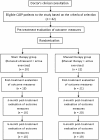Manual therapy followed by specific active exercises versus a placebo followed by specific active exercises on the improvement of functional disability in patients with chronic non specific low back pain: a randomized controlled trial
- PMID: 22925609
- PMCID: PMC3518179
- DOI: 10.1186/1471-2474-13-162
Manual therapy followed by specific active exercises versus a placebo followed by specific active exercises on the improvement of functional disability in patients with chronic non specific low back pain: a randomized controlled trial
Abstract
Background: Recent clinical recommendations still propose active exercises (AE) for CNSLBP. However, acceptance of exercises by patients may be limited by pain-related manifestations. Current evidences suggest that manual therapy (MT) induces an immediate analgesic effect through neurophysiologic mechanisms at peripheral, spinal and cortical levels. The aim of this pilot study was first, to assess whether MT has an immediate analgesic effect, and second, to compare the lasting effect on functional disability of MT plus AE to sham therapy (ST) plus AE.
Methods: Forty-two CNSLBP patients without co-morbidities, randomly distributed into 2 treatment groups, received either spinal manipulation/mobilization (first intervention) plus AE (MT group; n = 22), or detuned ultrasound (first intervention) plus AE (ST group; n = 20). Eight therapeutic sessions were delivered over 4 to 8 weeks. Immediate analgesic effect was obtained by measuring pain intensity (Visual Analogue Scale) before and immediately after the first intervention of each therapeutic session. Pain intensity, disability (Oswestry Disability Index), fear-avoidance beliefs (Fear-Avoidance Beliefs Questionnaire), erector spinae and abdominal muscles endurance (Sorensen and Shirado tests) were assessed before treatment, after the 8th therapeutic session, and at 3- and 6-month follow-ups.
Results: Thirty-seven subjects completed the study. MT intervention induced a better immediate analgesic effect that was independent from the therapeutic session (VAS mean difference between interventions: -0.8; 95% CI: -1.2 to -0.3). Independently from time after treatment, MT + AE induced lower disability (ODI mean group difference: -7.1; 95% CI: -12.8 to -1.5) and a trend to lower pain (VAS mean group difference: -1.2; 95% CI: -2.4 to -0.30). Six months after treatment, Shirado test was better for the ST group (Shirado mean group difference: -61.6; 95% CI: -117.5 to -5.7). Insufficient evidence for group differences was found in remaining outcomes.
Conclusions: This study confirmed the immediate analgesic effect of MT over ST. Followed by specific active exercises, it reduces significantly functional disability and tends to induce a larger decrease in pain intensity, compared to a control group. These results confirm the clinical relevance of MT as an appropriate treatment for CNSLBP. Its neurophysiologic mechanisms at cortical level should be investigated more thoroughly.
Trial registration number: NCT01496144.
Figures



References
-
- Ferreira ML, Ferreira PH, Latimer J, Herbert RD, Hodges PW, Jennings MD, Maher CG, Refshauge KM. Comparison of general exercise, motor control exercise and spinal manipulative therapy for chronic low back pain: A randomized trial. Pain. 2007;131:31–37. doi: 10.1016/j.pain.2006.12.008. - DOI - PubMed
Publication types
MeSH terms
Associated data
LinkOut - more resources
Full Text Sources
Medical

